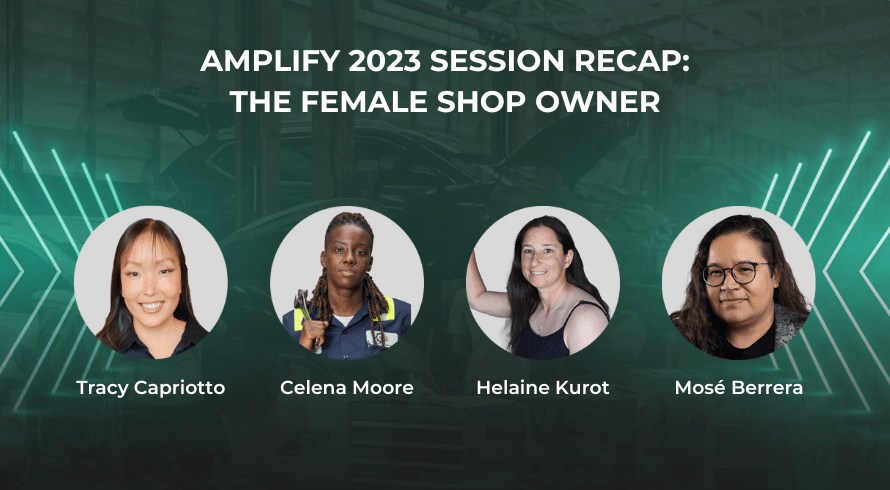A key breakout session at Amplify 2023 was the Female Shop Owner session, moderated by Tracy Capriotto, Director of Content and Producer at the Remarkable Results Radio Podcast.
On the panel, we had three amazing female shop owners:
- Celena Moore from Tech on the Way
- Helaine Knot from 360 Automotive & Consulting Services
- Mose Barerra from Mose Auto
All three came to Amplify with years of experience running their own shops and breaking the norms.
Together, the three women went over their journeys of running their own shop. They discussed:
- How did they get into auto repair
- Why are they passionate about it
- How they got started
- What prompted them to start their own shop
They also spoke about the challenges they have faced as a female in the auto repair industry and how they overcame them, along with the resources that helped them grow their business.
Let’s recap all the tips for female shop owners or females that would like to enter the industry.
» Want to grow your auto repair business? Click here to schedule a demo.
The challenges

Tracy introduced the women and started the session by discussing the challenges women face in the auto industry. Celena Moore spoke about how things have improved since she started 15 years ago in the industry.
People are much more accepting of female mechanics. Some women also prefer them because they perceive female mechanics to be more trustworthy. Helaine also seconded this. She also stated that older people share both shock and envy.
But the challenges still exist. The women summed them up like this:
- Customers on the diesel side still don’t trust women with their vehicles.
- There’s still shock and apprehension when customers meet a female mechanic.
- Although much less, women still face harassment in the field.
- Certain preconceived notions still exist, such as females can only be ‘wives’ of the owner, never the owner, and also ‘why should men be taking orders from a woman?’.
The group also unanimously agreed that if you have the conviction and expertise, you are bound to succeed regardless of gender.
But there are things you can do to improve your skill set and rise above the competition.
Offer internships & training

The group talked about the importance of creating awareness and education. A great way to do this is by offering internships and training. When the same people end up working for you, you create a workforce that is efficient and well-versed with all your SOPs.
Helaine Kurot shared her experience of onboarding an aspiring mechanic with zero automotive experience. What she saw in him was his drive and conviction to learn – great qualities to have when you’re looking to train someone!
Mose Berrera added that she goes to high schools and colleges to hunt for talent. Given how vast the auto industry is, you can offer multiple streams to young people and help them pursue their passions.
Once you’ve onboarded interns and apprentices, you need to train them well. Here are the tips our panelists shared:
- Start them young. Look for people who are early on in their careers. These people are easier to train, more passionate, and more likely to get interested in the automotive industry.
- Teach them the “whys” of each service. People care much more when they know why they’re doing what they’re doing.
- Offer diverse training opportunities. Make sure your apprentice isn’t just changing oil for six months straight.
- Ramp up the difficulty level gradually. You want your mechanics to be comfortable working on bigger projects without panicking.
- Supervise but also give them independence when you can.
- Keep your apprentices engaged. Make sure they enjoy what they’re doing.
- Take note of their strengths and use their abilities accordingly. This also helps your apprentices pave the right career path for themselves.
- Ensure everyone is following safety protocols. Keep reinforcing your SOPs
Get the right certifications
Are tech certifications worth the hype? It’s made all of us scratch our heads. Thankfully, Celena gave us a rundown.
The woman behind Tech on the Way believes the training these certifications offer are vital. You also need to implement them in your careers or you won’t gain much benefit.
With that said, you’re still better off with them, especially if you want to become a shop owner. Auto certifications “put you in a different market”. You’re able to offer services that are a notch above your counterparts. You’re made to focus on customer experience and offer premium care.
Certain auto work cannot be carried out if you don’t have ASE certifications. If you’re looking to expand your offerings, you need to get the right certifications.
Helaine also commented that her certifications really allowed her to enter the industry, overcome stereotypes, and ease apprehensions.
» Looking to transform your shop? Discover how AutoLeap can help.
Final thoughts
It’s intimidating to be a woman in an industry such as auto repair. We’re definitely a minority. But so many female shop owners have paved the way for today’s female entrepreneurs to easily carve a name for themselves.
All you need is perseverance, a growth mindset, and the confidence that you know as much as any other person in the field.
Frequently Asked Questions (FAQs)
Most vehicles from 1996 models to now are compatible with the OBD-2 scanner. However, if the vehicle is older than 1996, then you might need an OBD-1 scanner.
Using an OBD-2 scanner will not hurt your vehicle’s warranty. But if any issues or faults occur because you worked on the car or tuned it, it will void your vehicle’s warranty.
OBD-2 scanners with advanced features and functionalities support different makes and models. But you should always check if a certain vehicle is compatible with your scanner.
OBD-1 was a scanner used in earlier years. It connects to the console of a car. The OBD-2 is an advanced version of OBD-1 that most modern shops use. It offers better signaling protocols and messaging. It also provides more accurate results.
Software updates are available quarterly, after six months, or annually. Updates may become available online. Advanced updates might come about after a year. Your tool provider can guide you on specific update releases.









